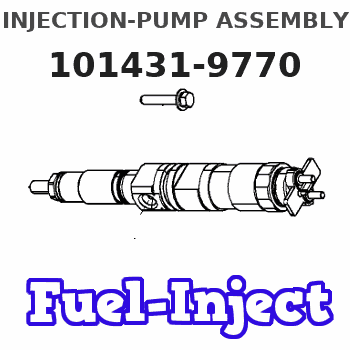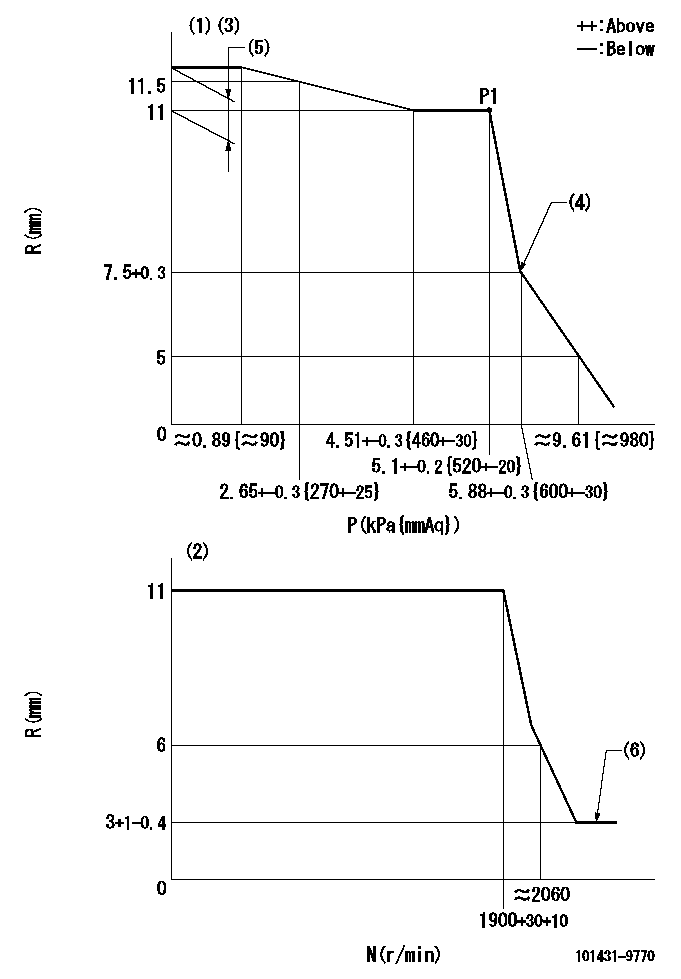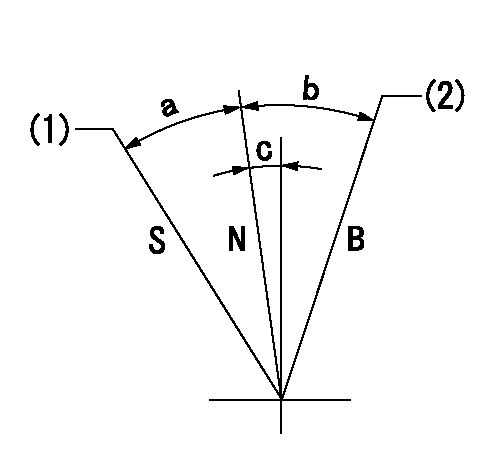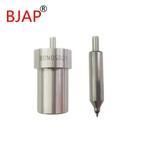Information injection-pump assembly
BOSCH
9 400 610 001
9400610001
ZEXEL
101431-9770
1014319770
NISSAN-DIESEL
16700Y1402
16700y1402

Rating:
Service parts 101431-9770 INJECTION-PUMP ASSEMBLY:
1.
_
6.
COUPLING PLATE
7.
COUPLING PLATE
8.
_
9.
_
11.
Nozzle and Holder
16600-90019
12.
Open Pre:MPa(Kqf/cm2)
9.8{100}
15.
NOZZLE SET
Cross reference number
BOSCH
9 400 610 001
9400610001
ZEXEL
101431-9770
1014319770
NISSAN-DIESEL
16700Y1402
16700y1402
Zexel num
Bosch num
Firm num
Name
101431-9770
9 400 610 001
16700Y1402 NISSAN-DIESEL
INJECTION-PUMP ASSEMBLY
SD22 * K
SD22 * K
Calibration Data:
Adjustment conditions
Test oil
1404 Test oil ISO4113 or {SAEJ967d}
1404 Test oil ISO4113 or {SAEJ967d}
Test oil temperature
degC
40
40
45
Nozzle and nozzle holder
105780-8140
Bosch type code
EF8511/9A
Nozzle
105780-0000
Bosch type code
DN12SD12T
Nozzle holder
105780-2080
Bosch type code
EF8511/9
Opening pressure
MPa
17.2
Opening pressure
kgf/cm2
175
Injection pipe
Outer diameter - inner diameter - length (mm) mm 6-2-600
Outer diameter - inner diameter - length (mm) mm 6-2-600
Tester oil delivery pressure
kPa
157
157
157
Tester oil delivery pressure
kgf/cm2
1.6
1.6
1.6
Direction of rotation (viewed from drive side)
Right R
Right R
Injection timing adjustment
Direction of rotation (viewed from drive side)
Right R
Right R
Injection order
1-3-4-2
Pre-stroke
mm
2.3
2.25
2.35
Beginning of injection position
Drive side NO.1
Drive side NO.1
Difference between angles 1
Cal 1-3 deg. 90 89.5 90.5
Cal 1-3 deg. 90 89.5 90.5
Difference between angles 2
Cal 1-4 deg. 180 179.5 180.5
Cal 1-4 deg. 180 179.5 180.5
Difference between angles 3
Cyl.1-2 deg. 270 269.5 270.5
Cyl.1-2 deg. 270 269.5 270.5
Injection quantity adjustment
Adjusting point
-
Rack position
12
Pump speed
r/min
800
800
800
Average injection quantity
mm3/st.
37.3
36.3
38.3
Max. variation between cylinders
%
0
-2.5
2.5
Basic
*
Fixing the rack
*
Injection quantity adjustment_02
Adjusting point
-
Rack position
11
Pump speed
r/min
1700
1700
1700
Average injection quantity
mm3/st.
37.3
35.7
38.9
Max. variation between cylinders
%
0
-4
4
Fixing the rack
*
Injection quantity adjustment_03
Adjusting point
-
Rack position
6
Pump speed
r/min
1700
1700
1700
Average injection quantity
mm3/st.
7
6.2
7.8
Max. variation between cylinders
%
0
-7.5
7.5
Fixing the rack
*
Injection quantity adjustment_04
Adjusting point
-
Rack position
7.7+-0.5
Pump speed
r/min
300
300
300
Average injection quantity
mm3/st.
7.5
6.4
8.6
Max. variation between cylinders
%
0
-15
15
Fixing the rack
*
Injection quantity adjustment_05
Adjusting point
-
Rack position
-
Pump speed
r/min
800
800
800
Average injection quantity
mm3/st.
37.3
36.8
37.8
Remarks
Set full load.
Set full load.
Timer adjustment
Pump speed
r/min
500
Advance angle
deg.
0.5
Timer adjustment_02
Pump speed
r/min
550
Advance angle
deg.
0.7
Timer adjustment_03
Pump speed
r/min
700
Advance angle
deg.
1
0.5
1.5
Timer adjustment_04
Pump speed
r/min
900
Advance angle
deg.
2
1.5
2.5
Timer adjustment_05
Pump speed
r/min
1100
Advance angle
deg.
3
2.5
3.5
Timer adjustment_06
Pump speed
r/min
1300
Advance angle
deg.
4
3.5
4.5
Timer adjustment_07
Pump speed
r/min
1500
Advance angle
deg.
5
4.5
5.5
Remarks
Finish
Finish
Test data Ex:
Governor adjustment

N:Pump speed
R:Rack position (mm)
P:Negative pressure
(1)Pneumatic governor
(2)Mechanical governor
(3)Acting negative pressure: P1
(4)Beginning of idle sub spring operation: L1
(5)Torque control stroke: L2
(6)Injection quantity Q = Q1 or less
----------
L1=7.5+0.3mm L2=1+-0.05mm Q1=3mm3/st
----------
----------
L1=7.5+0.3mm L2=1+-0.05mm Q1=3mm3/st
----------
Speed control lever angle

S:Stop
B:When boosted
N:Normal
(1)Rack position = aa
(2)Rack position bb
----------
aa=(1.8)mm bb=(18)mm
----------
a=20.5deg+-3deg b=14deg+-5deg c=3.5deg+-5deg
----------
aa=(1.8)mm bb=(18)mm
----------
a=20.5deg+-3deg b=14deg+-5deg c=3.5deg+-5deg
Information:
On engines with serial numbers 7LG1-7499, Inlet Air Temperature Sensors have Deutsch HD Connectors, 7LG7500-UP Inlet Air Temperature Sensors have DT Connectors.Schematic
Diagnostic Codes
Functional Test
P-527: Oil Pressure Circuit Test
System Operation
The 3176 system monitors oil pressure with a sensor located in the oil gallery (right side of engine). The oil pressure sensor is supplied with electrical power by the 5 volt sensor supply voltage from the ECM. Note that the 3176 uses oil pressure only as an engine protection function (available for 7LG7500-UP engines). Lack of oil pressure does not prevent the 3176 ECM from starting the engine. The 3176 ECM will still try to start the engine even if oil pressure is low.The 3176 system monitors oil pressure following engine start up and may show a 100-01 Low Oil Pressure Warning Diagnostic Code (46). The Diagnostic Code will not be logged for the first 15 seconds following engine start up, only ACTIVE.The Oil Pressure Sensor can measure oil pressure from 0 kPa (0 psi) to 690 kPa (100 psi).The 3176 oil pressure sensor is supplied with electrical power by the 5 volt sensor supply voltage from the ECM through connector J4/P4 Pin 10 to the Oil Pressure Sensor Connector P17/J17 Pin A. The Oil Pressure Sensor signal line routes from P17/J17 Pin C to J4/P4 pin 27. The Sensor Common routes from J4/P4 Pin 35 to P17/J17 pin B. the +5 V supply is shared with the Coolant Temperature, Inlet Air Temperature, and Coolant Level (if installed) Sensors. The Sensor Common is shared by the Coolant Temperature, and Inlet Air Temperature Sensors.Schematic
Diagnostic Codes
Functional Test
ECAP Example Screen of Oil Pressure Reading P-528: Boost Pressure Circuit Test And Sensor Calibration
System Operation
The 3176 system monitors boost pressure with a sensor located inside the Transducer Module. The boost pressure sensor is supplied with electrical through the Transducer Module Connector (inside the module) pin 1 (+8V). The signal routes through pin 2 (Boost Pressure) and Sensor Common is pin 3. The sensor can only be replaced by replacing the transducer module.The boost pressure is used to reduce smoke emissions during acceleration. 3176 limits the amount of fuel injected until certain boost pressures are reached. It does this by converting boost pressure to "FRC Fuel Post." (as shown on the ECAP status display). The FRC Fuel Pos. is electronic limit on the amount of fuel injected and is based on a ratio of fuel to air being supplied to the cylinders. It operates in a manner similar to the fuel ratio control on an engine with a mechanical governor.The inlet air hose from the air cleaner to the transducer module must be installed. The air inlet serves as a vent for the transducer module and is required for proper operation of the boost pressure sensor.The 3176 Boost Pressure Sensor must be calibrated for a zero boost condition with the engine off. Calibration is accomplished electronically without the need for manual adjustments. The sensor must be recalibrated whenever the ECM or transducer module has
Diagnostic Codes
Functional Test
P-527: Oil Pressure Circuit Test
System Operation
The 3176 system monitors oil pressure with a sensor located in the oil gallery (right side of engine). The oil pressure sensor is supplied with electrical power by the 5 volt sensor supply voltage from the ECM. Note that the 3176 uses oil pressure only as an engine protection function (available for 7LG7500-UP engines). Lack of oil pressure does not prevent the 3176 ECM from starting the engine. The 3176 ECM will still try to start the engine even if oil pressure is low.The 3176 system monitors oil pressure following engine start up and may show a 100-01 Low Oil Pressure Warning Diagnostic Code (46). The Diagnostic Code will not be logged for the first 15 seconds following engine start up, only ACTIVE.The Oil Pressure Sensor can measure oil pressure from 0 kPa (0 psi) to 690 kPa (100 psi).The 3176 oil pressure sensor is supplied with electrical power by the 5 volt sensor supply voltage from the ECM through connector J4/P4 Pin 10 to the Oil Pressure Sensor Connector P17/J17 Pin A. The Oil Pressure Sensor signal line routes from P17/J17 Pin C to J4/P4 pin 27. The Sensor Common routes from J4/P4 Pin 35 to P17/J17 pin B. the +5 V supply is shared with the Coolant Temperature, Inlet Air Temperature, and Coolant Level (if installed) Sensors. The Sensor Common is shared by the Coolant Temperature, and Inlet Air Temperature Sensors.Schematic
Diagnostic Codes
Functional Test
ECAP Example Screen of Oil Pressure Reading P-528: Boost Pressure Circuit Test And Sensor Calibration
System Operation
The 3176 system monitors boost pressure with a sensor located inside the Transducer Module. The boost pressure sensor is supplied with electrical through the Transducer Module Connector (inside the module) pin 1 (+8V). The signal routes through pin 2 (Boost Pressure) and Sensor Common is pin 3. The sensor can only be replaced by replacing the transducer module.The boost pressure is used to reduce smoke emissions during acceleration. 3176 limits the amount of fuel injected until certain boost pressures are reached. It does this by converting boost pressure to "FRC Fuel Post." (as shown on the ECAP status display). The FRC Fuel Pos. is electronic limit on the amount of fuel injected and is based on a ratio of fuel to air being supplied to the cylinders. It operates in a manner similar to the fuel ratio control on an engine with a mechanical governor.The inlet air hose from the air cleaner to the transducer module must be installed. The air inlet serves as a vent for the transducer module and is required for proper operation of the boost pressure sensor.The 3176 Boost Pressure Sensor must be calibrated for a zero boost condition with the engine off. Calibration is accomplished electronically without the need for manual adjustments. The sensor must be recalibrated whenever the ECM or transducer module has
Have questions with 101431-9770?
Group cross 101431-9770 ZEXEL
Nissan-Diesel
101431-9770
9 400 610 001
16700Y1402
INJECTION-PUMP ASSEMBLY
SD22
SD22
